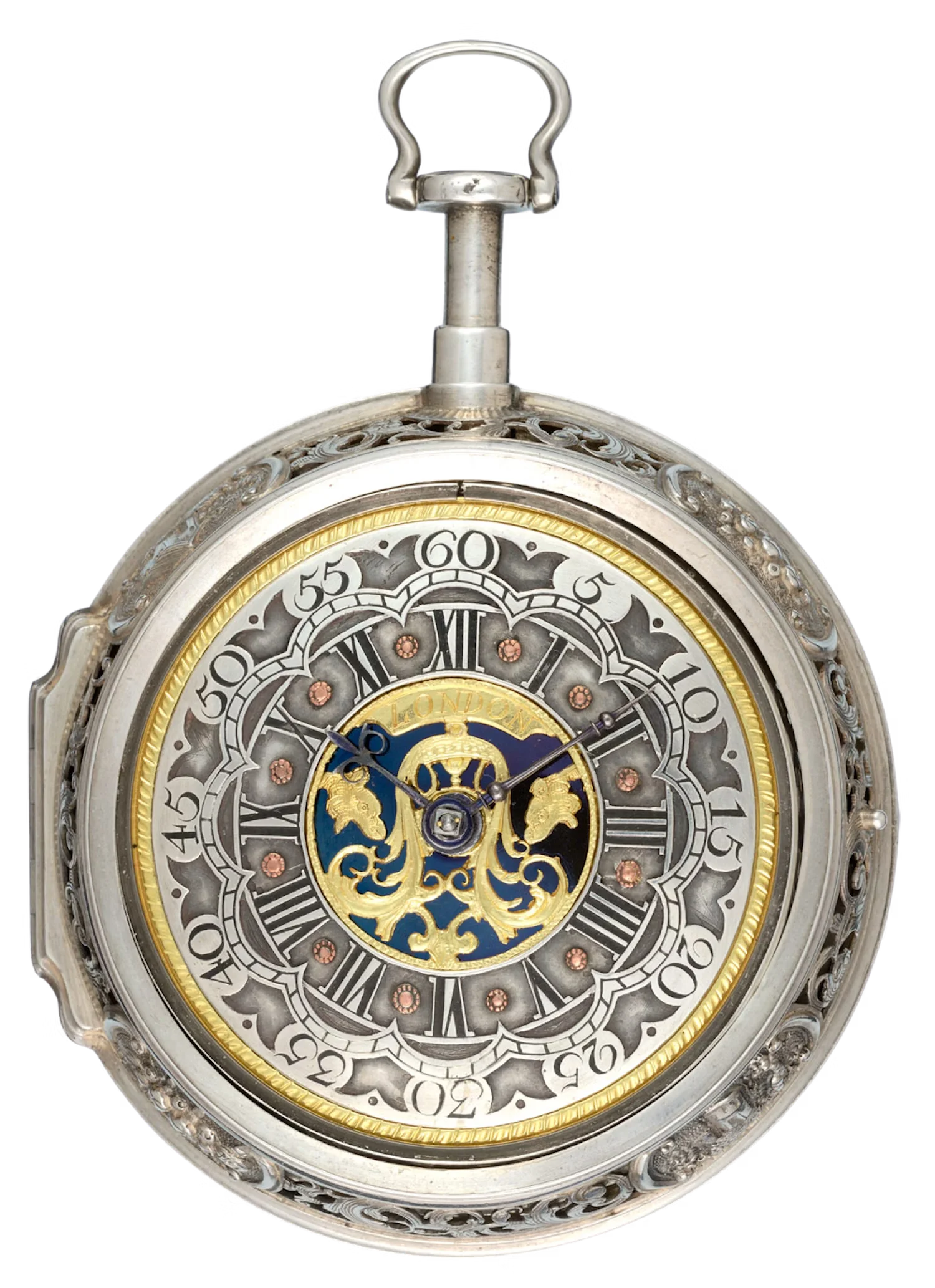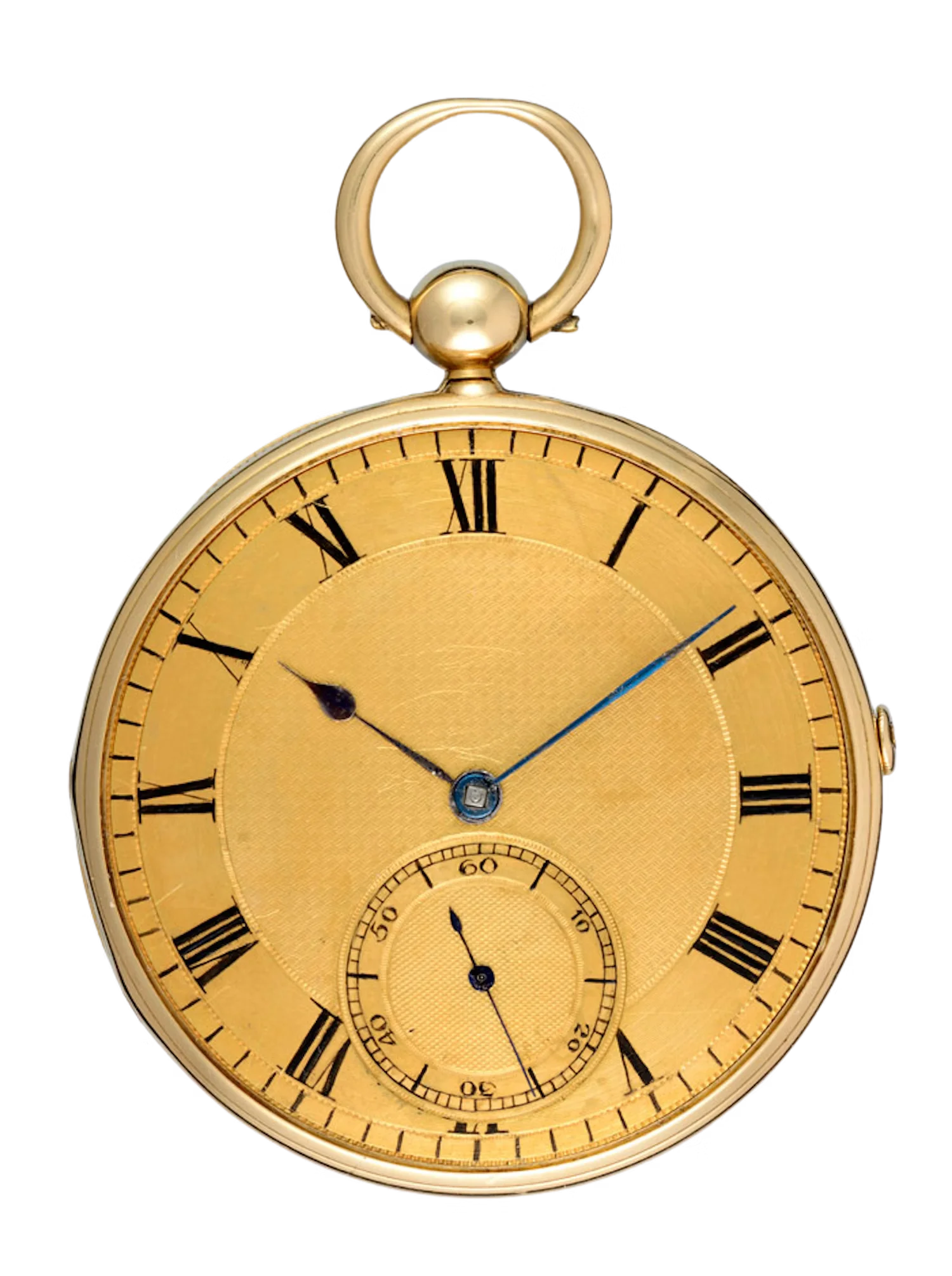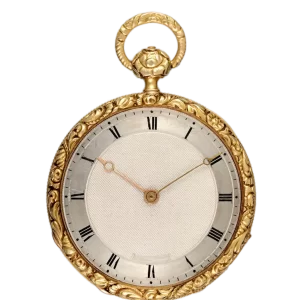ساعة ذهبية دوبلكس تكرار ربع الساعة - 1829
توقيع أرنولد آند دنت 84 ستراند لندن
مميزة لندن 1829
القطر 43 ملم
مواد
بريطانية قيراط ذهب للذهب عيار 18
£3,650.00
تعد ساعة GOLD QUARTER REPEATING DUPLEX - 1829 مثالًا رائعًا لصناعة الساعات الإنجليزية في القرن التاسع عشر، حيث تجسد الأهمية التاريخية والحرفية الرائعة. تتميز هذه الساعة، المتأثرة بصانع الساعات الفرنسي الأسطوري آل بريجيت، بمكبس متكرر نادر السحب والالتواء صممه بريجيت نفسه، والذي يقوم بتنشيط صنوجين من الفولاذ المصقول لإنشاء رنين مميز. مغلفة بعلبة مفتوحة من الذهب عيار 18 قيراطًا مع وسط مضلع، تعرض الساعة أيضًا قرصًا ذهبيًا تم تحويله إلى محرك مزين بأرقام رومانية باهتة وعقارب فولاذية زرقاء. تعتبر حركة المفتاح دليلاً على الهندسة الدقيقة، حيث تتميز بقضيب مذهّب، وبرميل متحرك معلق، وقضيب عادي مع منظم فولاذي مصقول، وتوازن مع نابض شعري حلزوني من الفولاذ الأزرق. يسلط ميزان الساعة المزدوج وعجلة الهروب النحاسية والمحاور ذات الأحجار النهائية الضوء على الاهتمام الدقيق بالتفاصيل. ومما يزيد من فضولها أن الساعة تحمل نقش "Dent, London - 264" على آلية الحركة، مما يشير إلى وجود اتصال بالكرونومتر بواسطة EJ Dent من 1829، بينما تم توقيع cuvette "Arnold & Dent 84 Strand London 3940, "يتوافق مع ترقيم أرنولد من عام 1826. ويثير هذا التوقيع المزدوج تساؤلات رائعة حول أصول الساعة، مما يشير إلى تصنيعها قبل الشراكة بين أرنولد ودنت ولكن بيعها بعد ذلك. إلى جانب جاذبيتها التاريخية، تقف ساعة GOLD QUARTER REPEATING DUPLEX - 1829 بمثابة شهادة على البراعة الفنية والتقنية لصناعة الساعات في القرن التاسع عشر، مما يجعلها ملكية ثمينة لهواة جمع الساعات والمتحمسين على حدٍ سواء.
تُعد هذه الساعة المزدوجة التي يرجع تاريخها إلى الربع الإنجليزي من القرن التاسع عشر قطعة رائعة من الحرفية، متأثرة بصانع الساعات الفرنسي الشهير آل بريجيت. تتميز الساعة بمكبس متكرر نادر للسحب والالتواء، صممه بريجيت بنفسه، والذي يشغل صنوجي فولاذيين مصقولين ينتجان رنينًا فريدًا. تتميز الساعة أيضًا بعلبة مفتوحة من الذهب عيار 18 قيراطًا مع وسط مضلع، وقرص ذهبي مُدار بمحرك بأرقام رومانية باهتة، وعقارب فولاذية زرقاء.
حركة الساعة عبارة عن مفتاح ملفوف بقضيب مذهّب وتتميز ببرميل متحرك معلق، وقضيب عادي مع منظم من الفولاذ المصقول، وميزان تعويض مع نابض حلزوني من الفولاذ الأزرق. يُظهر ميزان الساعة المزدوج وعجلة الهروب النحاسية والمحاور ذات الأحجار النهائية تفاني صانع الساعات في الدقة والدقة.
ما يجعل هذه الساعة أكثر إثارة للاهتمام هو توقيعها وترقيمها. منقوش على آلية الحركة عبارة "Dent, London - 264"، والتي يبدو أنها تتوافق مع الكرونومتر من تصميم EJ Dent والذي يحمل أيضًا علامة 1829. ومع ذلك، فإن الكوفيت يحمل توقيع "Arnold & Dent 84 Strand London 3940"، بما يتماشى مع ترقيم أرنولد لساعة رقم 3840 تحمل علامة 1826. وهذا يثير تساؤلات حول أصول الساعة، حيث يبدو أنها تم تصنيعها قبل أن يصبح أرنولد ودينت شريكين ولكن تم بيعهما بعد ذلك.
بالإضافة إلى أهميتها التاريخية، تعتبر هذه الساعة أيضًا شهادة على براعة صناعة الساعات وفنونها في القرن التاسع عشر. تصميمها المعقد وميزاتها التقنية يجعلها قطعة فريدة وقيمة لأي جامع أو متحمس.
توقيع أرنولد آند دنت 84 ستراند لندن
مميزة لندن 1829
القطر 43 ملم
مواد
بريطانية قيراط ذهب للذهب عيار 18











